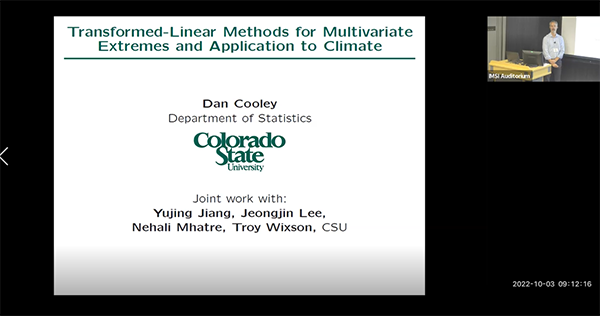Transformed-Linear Methods for Multivariate Extremes and Application to Climate
Presenter
October 3, 2022
Event: Climate and Weather Extremes
Abstract
Statistical methods for extremes are widely used in climate science. Distributions like the generalized extreme value and generalized Pareto are familiar tools used by climate scientists to describe the extreme behavior of univariate data. Multivariate (and spatial and time series) extremes largely focuses on accurately capturing the tail dependence of several variables. Multivariate extremes models can be complicated and can be difficult to fit in high dimensions. In this talk, we will use methods from classical (non-extreme) statistics as inspiration to create sensible methods for multivariate extremes. Many classical statistical methods (e.g., PCA, spatial, factor analysis, and time series) employ the covariance matrix to learn about dependence, to construct models, or to perform prediction. Most familiar statistics methods are linear. However, extremal dependence is poorly described by the covariance matrix. Linear methods have not been widely employed for extremes, and are difficult to implement for data that are non-negative. In this talk, we will introduce transformed linear methods for extremes. By using the tail pairwise dependence matrix (TPDM) in place of the covariance matrix, and by employing transformed linear operations, extreme analogues which focus on the upper tail can be developed for familiar linear statistical methods. Here, we will focus on developing transformed linear time series models to capture dependence in the upper tail. These models are extremal analogues to familiar ARMA models. We apply these models to perform attribution for seasonal wildfire conditions. To focus on change in fire risk due to climate, we model the fire weather index (FWI) time series. We use our fitted model to perform an attribution study. According to our fitted model, the 2020 Colorado fire season is many times more likely to occur under recent climate than under the climate of 50 years ago. If time allows, we will also present results from a PCA analysis of CONUS extreme precipitation. (Joint work with Troy Wixson, CSU)
